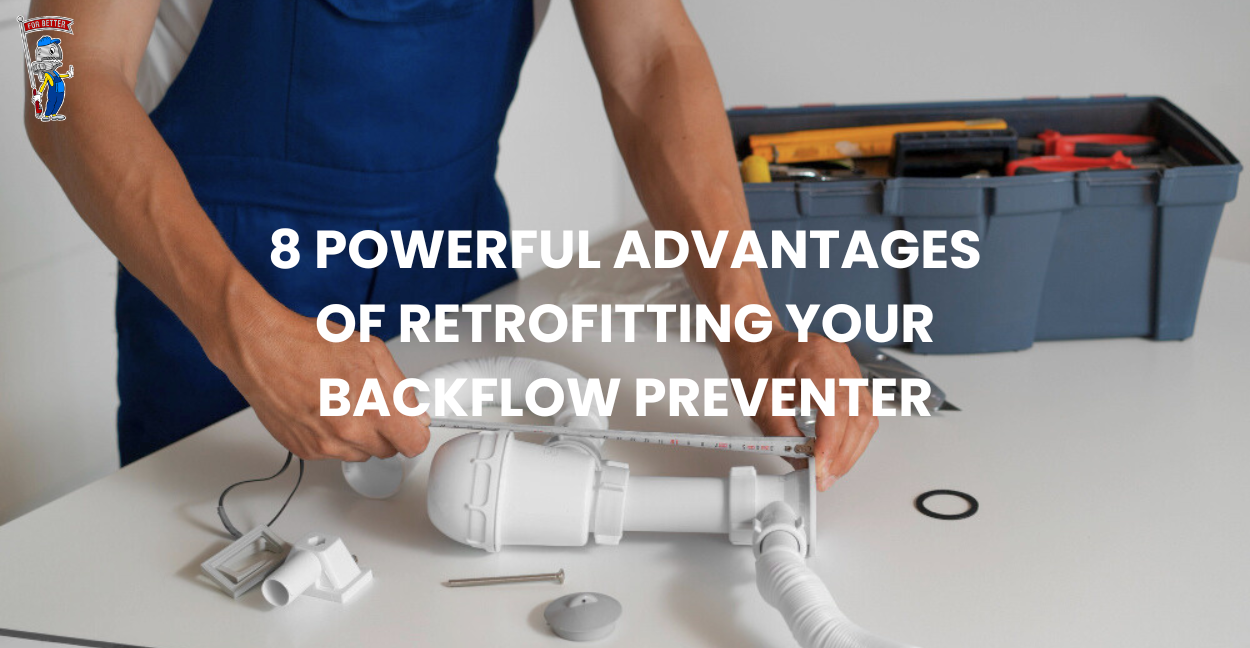In plumbing, retrofitting backflow preventers is important for keeping water safe. In this article, we will discuss the advantages of retrofitting backflow preventers, highlighting their significance in modern plumbing infrastructure and much more.
What is Retrofitting?
Retrofitting refers to the process of upgrading or modifying existing structures, systems, or components to improve their performance, efficiency, functionality, or sustainability. It involves incorporating new technologies, materials, or designs into older buildings or infrastructure to align them with modern standards, regulations, or environmental considerations.
Advantages of Retrofitting Your Backflow Preventers
Backflow preventers play a crucial role in safeguarding water quality and preventing contamination in plumbing systems. Retrofitting these devices offers numerous advantages, ensuring both efficiency and safety. Let’s explore the benefits of retrofitting backflow preventers and why it’s a wise investment for your plumbing infrastructure.
1.) Protecting Water Quality
The primary advantage of retrofitting backflow preventers is the protection of water quality. These devices prevent the reverse flow of contaminated water into clean water supplies, ensuring that drinking water remains safe and free from pollutants or harmful substances.
2.) Compliance with Regulations
Retrofitting backflow preventers helps businesses and property owners comply with regulatory requirements. Many jurisdictions mandate the installation of backflow prevention devices to prevent cross-connections and maintain water safety standards. Retrofitting ensures adherence to these regulations, avoiding penalties and legal issues.
3.) Preventing Health Risks
Backflow incidents can pose significant health risks, especially in commercial and industrial settings where hazardous substances may be present. Retrofitting backflow preventers mitigates these risks by preventing the backflow of chemicals, bacteria, or other contaminants into the water supply, safeguarding public health.
4.) Preserving System Integrity
By retrofitting backflow preventers, you protect the integrity of your plumbing system. Backflow events can cause damage to pipes, fixtures, and appliances due to the introduction of corrosive or harmful substances. Preventing backflow extends the lifespan of your plumbing infrastructure, reducing maintenance costs and disruptions.
5.) Insurance Requirements
Many insurance companies require the installation of backflow preventers as a condition for coverage. Retrofitting these devices not only fulfils insurance requirements but also demonstrates a commitment to risk management and property protection, potentially leading to lower insurance premiums.
6.) Ensuring Business Continuity
For businesses that rely on uninterrupted water supply, such as restaurants, hospitals, and manufacturing facilities, retrofitting backflow preventers is essential for ensuring business continuity. Any disruption or contamination of water supply can have serious consequences, including regulatory fines, reputational damage, and operational disruptions.
7.) Environmental Responsibility
Retrofitting backflow preventers aligns with environmental responsibility and sustainability goals. By preventing water contamination and waste, you contribute to conservation efforts and reduce your ecological footprint, promoting a healthier environment for current and future generations.
8.) Long-Term Cost Savings
While the initial investment in retrofitting backflow preventers may seem significant, it offers long-term cost savings. By avoiding costly repairs, water damage incidents, regulatory fines, and business disruptions, retrofitting proves to be a financially prudent decision over time, protecting your investment and bottom line.
Ready to enhance your water system’s safety and efficiency? Contact us today to discuss retrofitting options and safeguard your water supply for a healthier, more resilient future.
Exploring Different Types of Backflow Preventer Retrofitting
Backflow preventers are crucial components in plumbing systems, ensuring the safety and quality of water supply by preventing the reverse flow of contaminants. Retrofitting backflow preventers involves upgrading or modifying existing systems to enhance efficiency, compliance, and safety. Let’s delve into the various types of backflow preventer retrofitting and their benefits.
Pressure Vacuum Breaker (PVB) Retrofitting
A Pressure Vacuum Breaker (PVB) is a type of backflow preventer commonly used in residential and commercial settings. Retrofitting PVBs involves upgrading older models with newer, more efficient designs. Benefits of PVB retrofitting include improved reliability, reduced maintenance requirements, and enhanced protection against backflow incidents.
Double Check Valve (DCV) Retrofitting
Double Check Valve (DCV) backflow preventers are widely employed in applications where moderate hazard protection is required. Retrofitting DCVs involves replacing worn-out components, updating valve technology, and ensuring compliance with current standards. DCV retrofitting improves reliability, reduces leakage risks, and enhances system performance.
Reduced Pressure Zone (RPZ) Retrofitting
RPZ backflow preventers offer high-level protection against backflow in high-risk environments such as industrial facilities and large commercial buildings. Retrofitting RPZ devices involves upgrading outdated models with advanced features, conducting thorough testing and calibration, and certifying compliance with regulatory standards. RPZ retrofitting ensures optimal performance, minimal maintenance, and maximum safety.
Air Gap Retrofitting
Air gaps provide a physical barrier between potable water sources and potential contaminants, making them highly effective backflow prevention devices. Retrofitting air gaps involves optimizing installation configurations, ensuring proper height and distance requirements, and implementing additional safety measures as needed. Air gap retrofitting guarantees robust backflow prevention and regulatory compliance.
Retrofitting Process for Backflow Preventers
Assessment: The first step is to assess the existing backflow preventer system. This includes evaluating its age, condition, functionality, and compliance with current standards.
Design and Planning: Based on the assessment, a retrofitting plan is developed. This involves designing upgrades or replacements that align with regulatory requirements and improve system performance.
Procurement of Materials: Once the retrofitting plan is finalized, the necessary materials, parts, and equipment are procured. This ensures that the retrofitting process proceeds smoothly without delays.
Installation and Retrofitting: Skilled technicians install the new backflow preventer components according to the retrofitting plan. This may involve replacing valves, upgrading sensors, or adding monitoring systems for improved functionality.
Testing and Calibration: After installation, thorough testing and calibration are conducted to ensure that the retrofitting measures are effective. This includes pressure testing, flow rate checks, and calibration of control mechanisms.
Compliance Verification: Regulatory authorities may conduct inspections to verify compliance with standards and regulations. Documentation of the retrofitting process and certifications may be required.
Training and Maintenance: Building occupants or maintenance personnel are trained on the operation and maintenance of the retrofitted backflow preventers. Regular maintenance schedules are established to ensure ongoing performance and compliance.
Factors to Consider Before Retrofitting
1. Assessment of Current Conditions
Before retrofitting, it’s crucial to assess the current conditions of the structure or system. This includes evaluating its age, performance, maintenance history, and compliance with regulations. Understanding the existing conditions helps in identifying areas for improvement and setting realistic retrofitting goals.
2. Purpose and Objectives
Define the purpose and objectives of the retrofitting project. Are you aiming to improve energy efficiency, enhance safety, comply with regulations, or upgrade outdated components? Clearly defining the goals helps in selecting the most suitable retrofitting strategies and measuring the success of the project.
3. Budget and Resources
Determine the budget and resources available for the retrofitting project. Consider factors such as material costs, labor expenses, permits, and consulting fees. Allocate resources effectively to ensure that the retrofitting project stays within budget constraints without compromising quality or safety.
4. Regulatory Compliance
Ensure compliance with regulatory requirements and standards relevant to the retrofitting project. This may include building codes, environmental regulations, safety standards, and permits. Failure to comply with regulations can lead to legal issues, penalties, and project delays.
5. Environmental Impact
Evaluate the environmental impact of the retrofitting project. Choose eco-friendly materials, technologies, and practices that minimize environmental footprint and promote sustainability. Consider factors such as energy efficiency, waste reduction, and resource conservation in your retrofitting plans.
6. Technical Feasibility
Assess the technical feasibility of the retrofitting measures being considered. Consult with experts, engineers, and contractors to determine the practicality and effectiveness of proposed upgrades or modifications. Consider factors such as structural integrity, compatibility with existing systems, and long-term maintenance requirements.
FAQs
1.) How does retrofitting backflow preventers save money?
Retrofitting backflow preventers saves money in several ways. Firstly, it prevents the contamination of clean water by dirty water, which could lead to costly repairs and health hazards. By avoiding these issues, property owners save money on potential damages and legal consequences. Additionally, some regions offer incentives or rebates for installing backflow preventers, further reducing the overall cost.
2.) Are there any benefits or discounts for retrofitting?
Yes, there are benefits and discounts available for retrofitting backflow preventers. These benefits include improved water safety, compliance with regulations, and enhanced system performance. Some government agencies or utility companies may offer incentives, rebates, or discounts for property owners who retrofit backflow preventers, encouraging proactive measures to protect water quality.
3.) What’s the difference between retrofitting and installing new preventers?
Retrofitting involves adding backflow preventers to existing plumbing systems, while installing new preventers means putting them in during the initial construction or renovation phase. Retrofitting is often done to upgrade older systems or comply with new regulations without completely replacing the plumbing infrastructure. Installing new preventers is typically more expensive and involves integrating them into the initial design of the plumbing system.
4.) Can backflow preventers be customized for different systems?
Yes, backflow preventers can be customized to suit different plumbing systems and applications. There are various types of preventers available, such as pressure vacuum breakers, double-check valves, and reduced pressure zone assemblies. The choice of preventer depends on factors like water pressure, system layout, and the level of protection required. Certified professionals can assess the system and recommend the most suitable preventer for specific needs.
5.) How often should we check retrofitted preventers for best results?
It’s recommended to check retrofitted preventers regularly to ensure optimal performance and compliance with regulations. The frequency of checks depends on factors like the type of preventer, local regulations, and system usage. Generally, backflow preventers should be tested annually by certified professionals to verify functionality and safety. Additionally, property owners should conduct visual inspections periodically to detect any signs of damage or malfunction.
Contact Backflow Services Done Right
Ensuring the safety and quality of your water supply is crucial for your health and well-being. Take action today by considering retrofitting backflow preventers in your plumbing system. Not only does this proactive step save you money in the long run by preventing costly damages, but it also keeps your water clean and compliant with regulations. Don’t wait for problems to arise—invest in the protection of your water system now. Contact us if you are looking for professional Backflow services in Fairfax and Arlington. Your water’s safety is worth the proactive effort!



